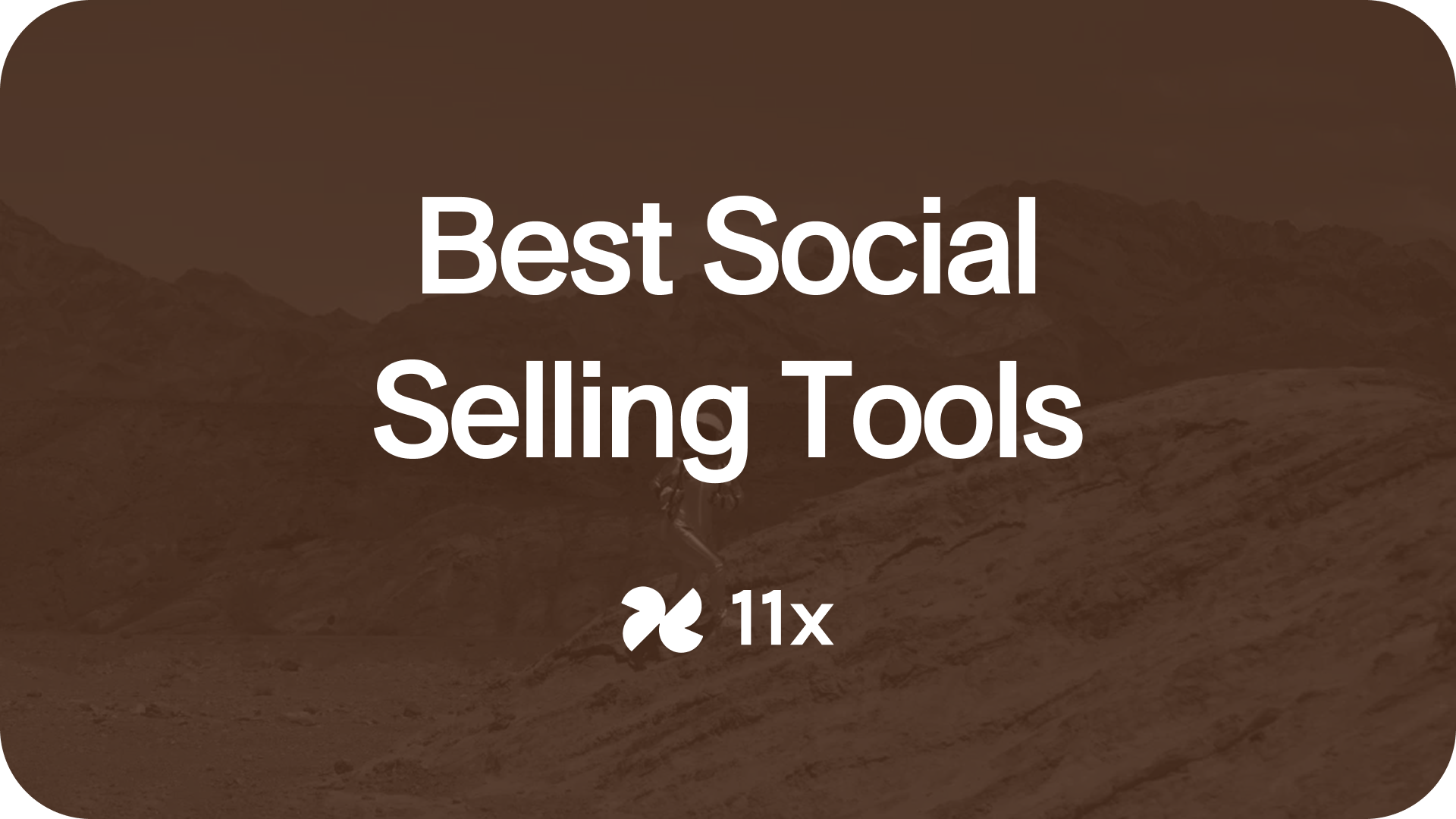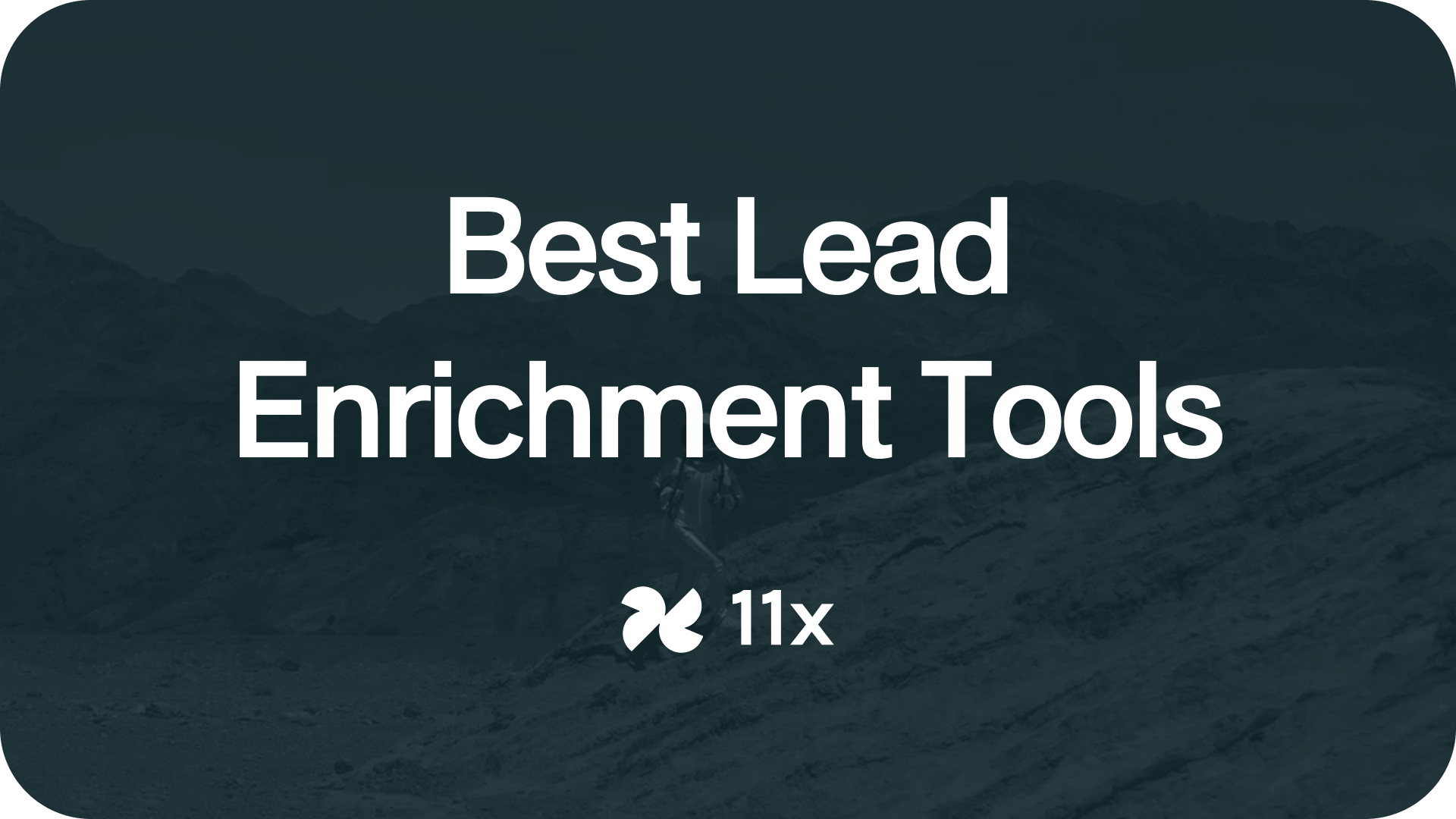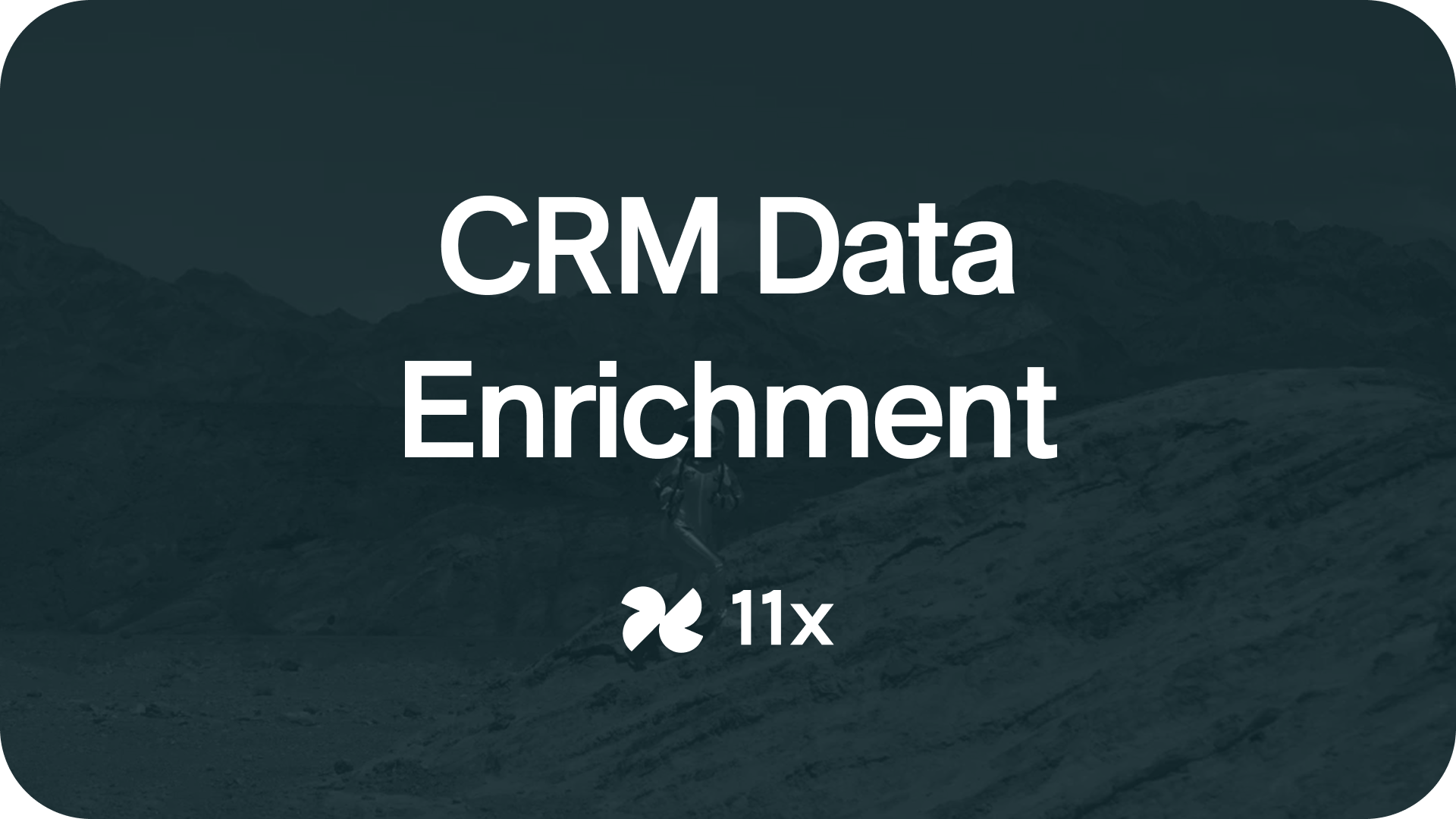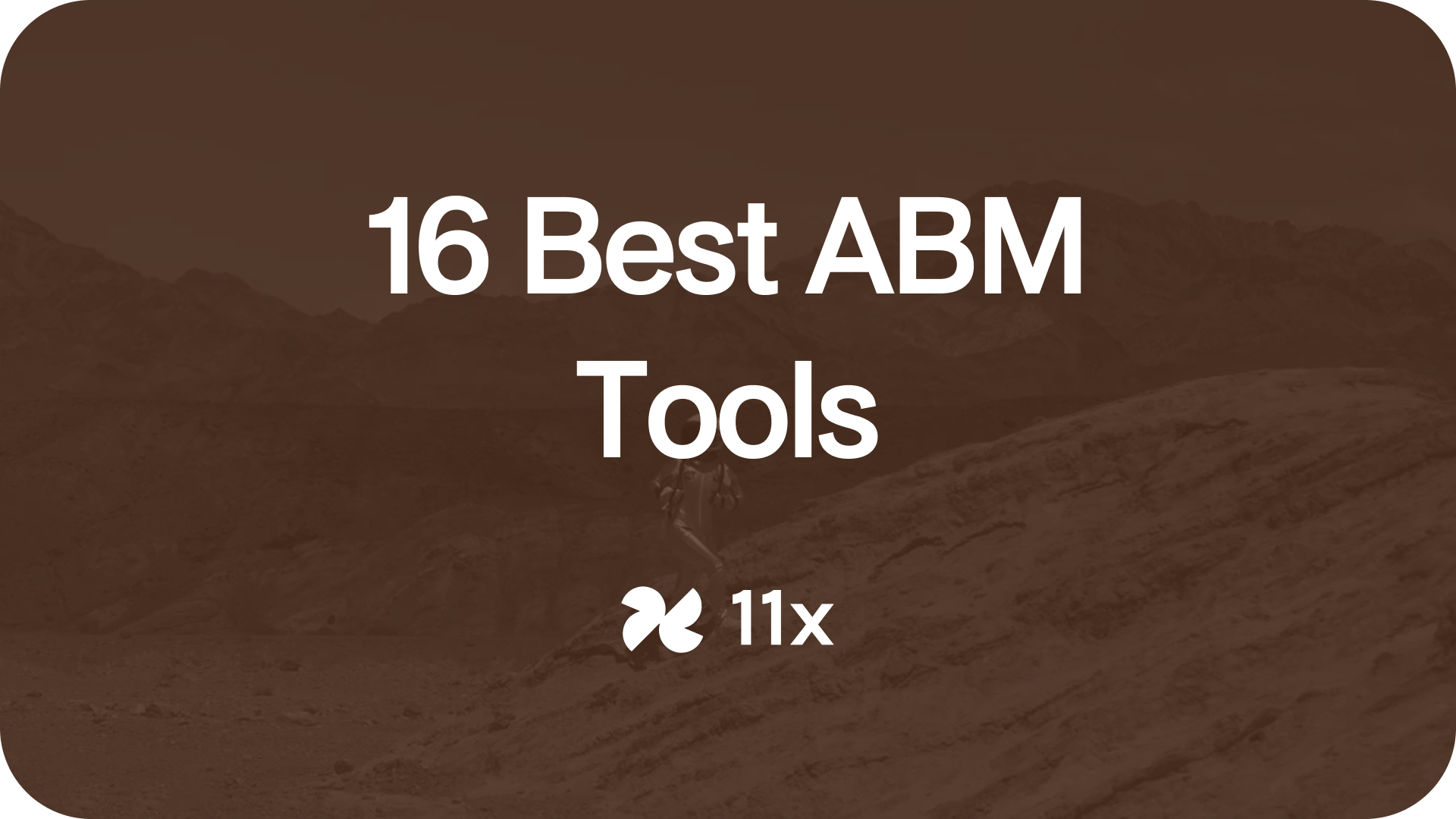Top 6 AI BDRs to Automate and Scale Sales in 2026
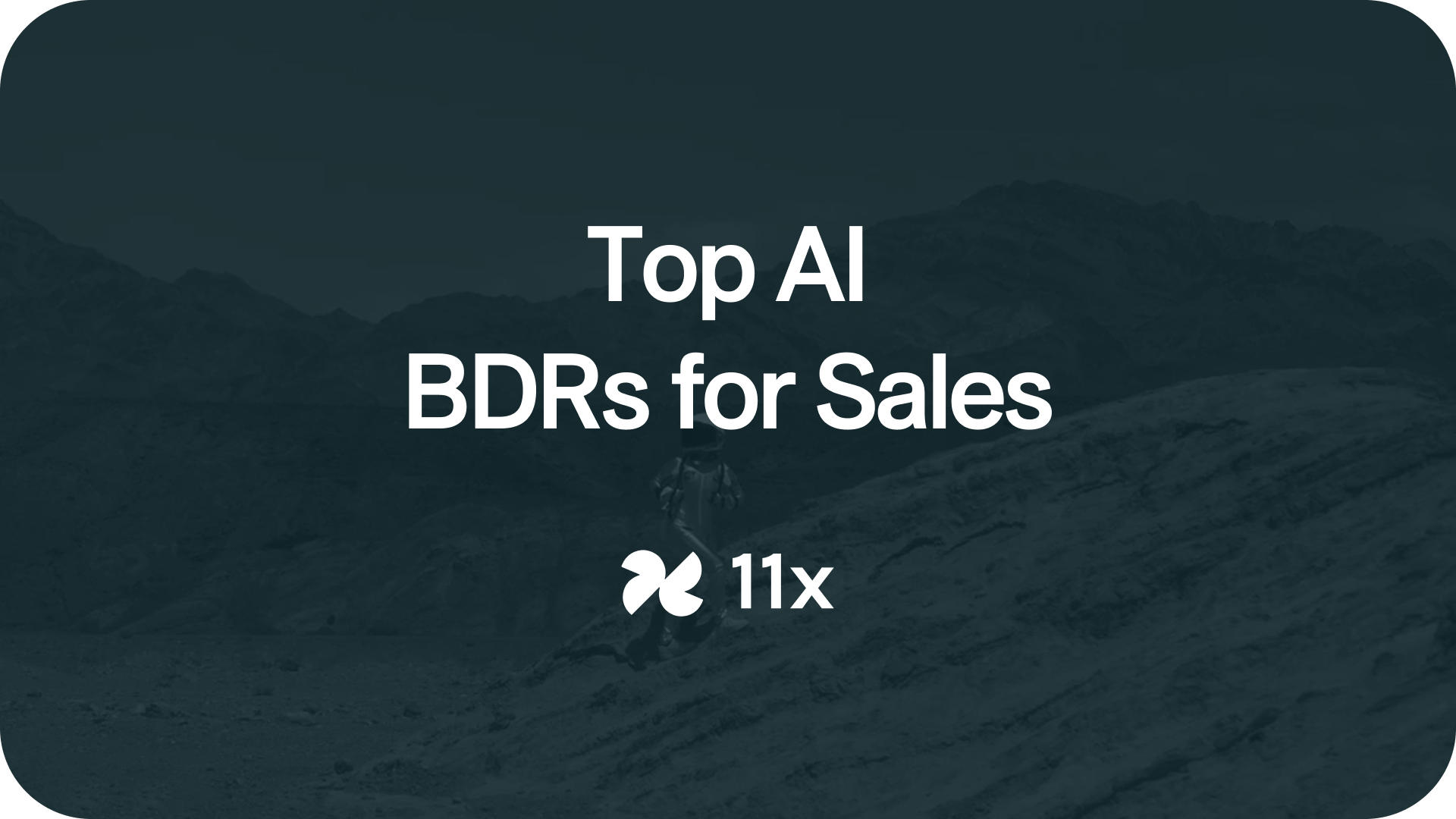
Outbound sales have changed. Manual prospecting, cold calling, and CRM updates are too slow to keep up with modern buyer behavior. Sales teams need faster follow-ups, scalable outreach, and real-time lead qualification, without adding more headcount or tools.
That’s where AI BDRs come in.
AI BDRs or Artificial Intelligence Business Development Representatives are digital workers that automate top-of-funnel sales workflows. They generate leads, enrich contact data, send personalized messages, and qualify interest across channels like email and LinkedIn. Unlike traditional automation tools, AI BDRs adapt to engagement signals and execute workflows without constant oversight.
This guide breaks down how AI BDRs work, how they differ from AI Sales Agents, and which tools are best suited for different GTM teams.
What Is an AI BDR?
Traditional Business Development Representatives manually built lists, sent cold emails, updated CRM records, and chased follow‑ups day after day. It was a labor‑intensive system that slowed the sales process.
AI BDRs replace those repetitive tasks through autonomous execution. They use AI to generate personalized emails, detect intent signals across web and social media, and maintain data accuracy in CRM systems. The result is a streamlined workflow that runs 24/7, identifying and qualifying potential leads automatically.
Our Selection Criteria
The tools featured in this guide were evaluated using a transparent, reasoning-based methodology designed to highlight measurable outcomes over marketing claims.
Each platform was analyzed across five dimensions central to modern sales automation: automation depth, integration quality, scalability, data accuracy, and ROI impact, combining 90% objective feature comparison with 10% strategic context from real sales operations. This balanced framework ensures clarity, credibility, and consistency in how every AI BDR tool is benchmarked.
- Automation Depth carries the greatest weight. It measures how effectively a system streamlines repetitive workflows and executes multi-channel outreach without constant human input. Platforms that demonstrate true AI-driven autonomy, handling research, personalized emails, follow-ups, and reporting, score highest in this category.
- Integration Quality evaluates how seamlessly each solution connects to core CRM systems such as Salesforce, HubSpot, and Pipedrive. Deep, bi-directional synchronization is essential for maintaining clean pipeline data, reducing manual entry, and linking AI insights directly to sales engagement.
- Scalability examines how well a tool handles growth, supporting larger outbound sales volumes, multiple languages, and global send capabilities without performance loss or deliverability risks. Highly scalable automation allows teams to expand their outreach without increasing headcount.
- Data Accuracy focuses on how reliably the platform enriches records, scores leads, and interprets intent signals. Solutions that aggregate real-time data points and verify contacts before outreach produce a steady flow of qualified leads and stronger conversion rates.
- ROI Impact determines how quickly users see improvements in pipeline velocity, open rates, and cost per qualified lead. Top-performing tools demonstrate clear financial and operational gains through AI-powered optimization.
By weighting quantitative results against strategic insight, this methodology positions 11x as the industry benchmark for real-time, full-cycle AI execution across the modern sales process.
High‑Level Comparison of Top AI BDR Tools
11x
- Automation Level: Full-cycle AI SDR execution
- CRM Integrations: Salesforce, HubSpot, Pipedrive
- Key Strength: Autonomous research + outreach + follow-up
- Best For: Teams running end-to-end AI sales automation
- Pricing (est.): Custom
Lyne.ai
- Automation Level: Email personalization
- CRM Integrations: HubSpot, Outreach
- Key Strength: Natural-language icebreakers
- Best For: Startups focusing on cold email
- Pricing (est.): $120/mo
OutboundFlow
- Automation Level: Multi-channel sequencing
- CRM Integrations: HubSpot, Salesforce
- Key Strength: Orchestrated email + LinkedIn
- Best For: B2B organizations executing cross-channel campaigns
- Pricing (est.): $199–$299/mo
Clay
- Automation Level: Data enrichment at scale
- CRM Integrations: API
- Key Strength: Deep data sources and AI lead scoring
- Best For: RevOps and Ops teams building lists
- Pricing (est.): $249/mo
Instantly.ai
- Automation Level: Deliverability automation
- CRM Integrations: SMTP, Gmail
- Key Strength: Domain warming and inbox rotation
- Best For: Marketers focused on email reputation
- Pricing (est.): $37–$97/mo
Smartlead.ai
- Automation Level: Campaign management
- CRM Integrations: HubSpot, Salesforce
- Key Strength: High-volume coordination and analytics
- Best For: Agencies and enterprises
- Pricing (est.): $39–$79/mo
The Best AI BDR Tools for 2025
Below are the most capable AI‑powered BDR platforms in 2025, each strong in a specific function area, but none as complete as 11x’s autonomous SDR system.
1. 11x
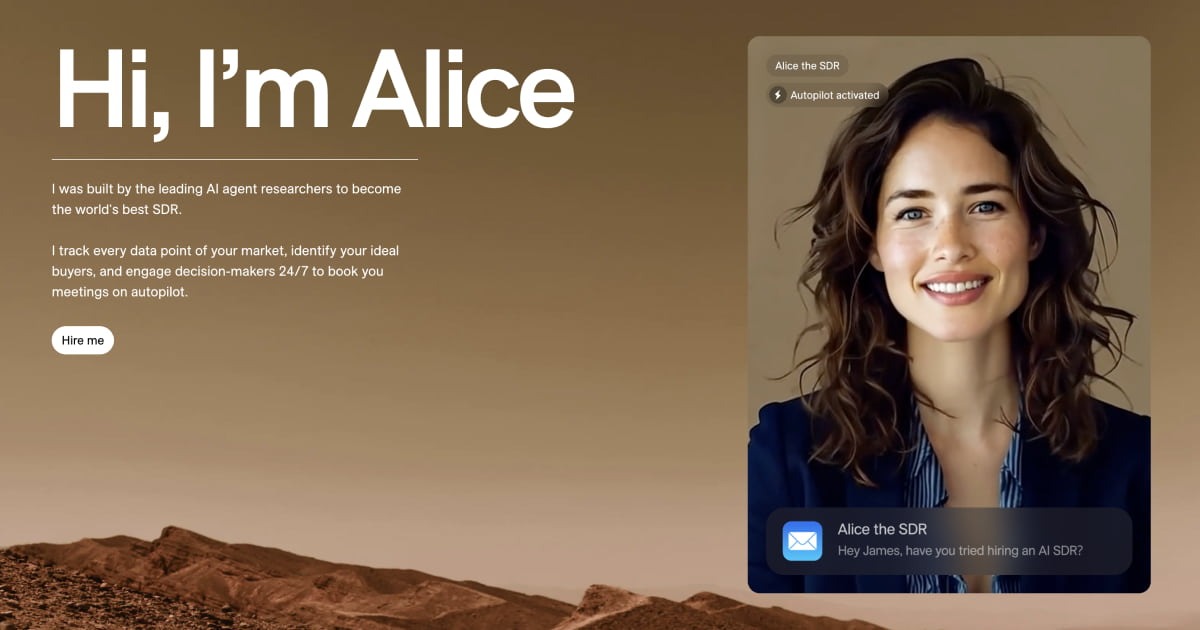
11x unifies data enrichment, AI research, and multi‑channel outreach in one platform. Its digital workers, Alice and Julian, act like always‑on SDRs: analyzing intent signals, identifying pain points, and launching personalized emails and calls autonomously. All activity feeds back into connected CRM systems to streamline the sales process and expand pipeline visibility.
- Capabilities: Lead generation and enrichment, personalized outreach across email and LinkedIn, real-time intent tracking with deep research agents, and bi-directional CRM syncs.
- Pros: 24/7, multilingual operation and enterprise-grade security (GDPR, SOC 2, and CASA compliance).
- Best Fit: Organizations ready to unify sales tools into one autonomous AI system that creates and qualifies a pipeline automatically.
- Pricing: Custom plans based on team size and automation scope.
- ROI Impact: Gupshup saw a 50% increase in SQLs per SDR after adopting Alice, enabling a 1.5× boost in output per rep—and freeing up time for strategic initiatives like calling and rapid campaign testing, all without increasing headcount.
2. Lyne.ai
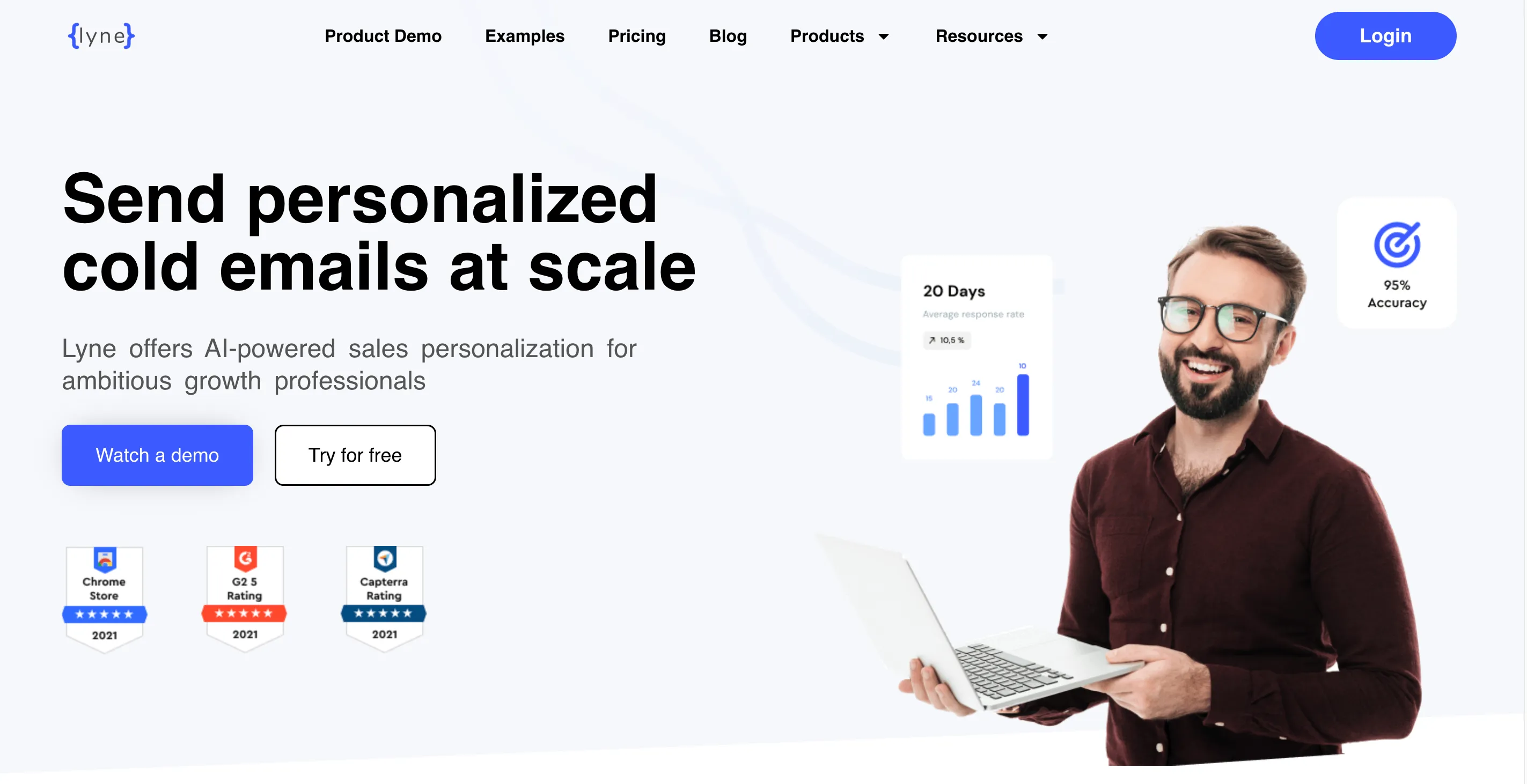
Lyne.ai automates cold email personalization with contextual, sentence‑level copy built from LinkedIn and CRM data. It analyzes target profiles, extracts unique details, and writes natural openings that increase engagement without human drafting. All messages sync to your outreach platform to keep campaigns consistent across the sales process and maintain clean CRM reporting.
- Pros: High‑quality personalization; easy setup; strong LinkedIn enrichment.
- Cons: Limited to email, no multi‑channel or dialer automation.
- Best Fit: Startups running targeted cold outreach campaigns that want AI‑generated copy; teams scaling beyond email should consider 11x for multi‑channel autonomy.
- Pricing: ≈ $120 per month.
3. OutboundFlow
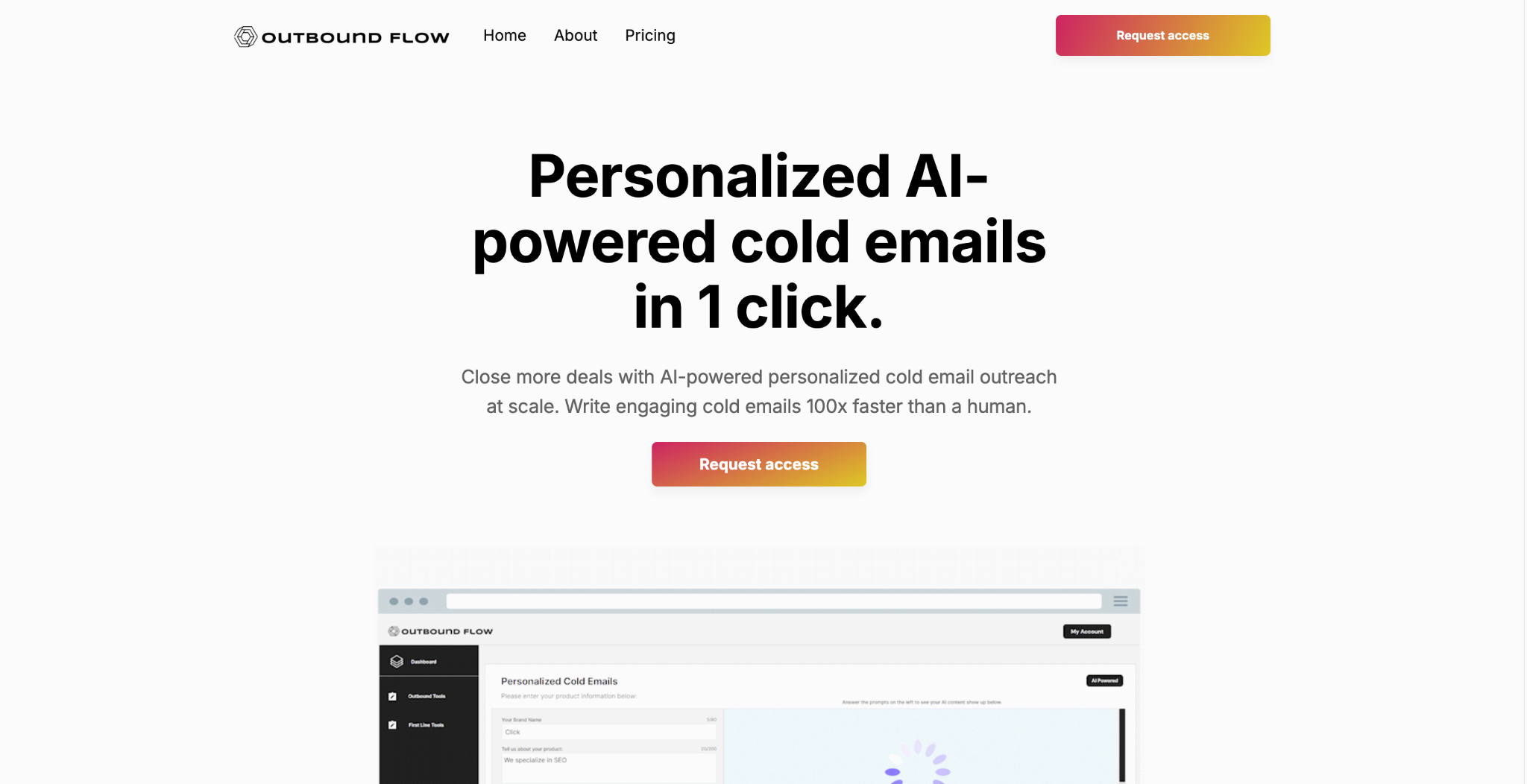
Outboundflow coordinates multi‑channel outreach across email, LinkedIn, SMS, and dialer calls from one interface. It analyzes activity data to decide which channel or message type to trigger next, improving touch‑to‑response ratios. Every outreach action and reply syncs back to Salesforce or HubSpot to preserve context and strengthen overall sales pipeline visibility.
- Pros: Robust multi‑channel coordination; clear performance tracking.
- Cons: Manual lead scoring; lacks native personalization AI.
- Best Fit: B2B organizations running large‑scale outbound sales; adding 11x introduces autonomous lead qualification and adaptive AI learning.
- Pricing: $199–$299 per month.
4. Clay

Clay aggregates over fifty live data sources to enrich leads, score intent, and surface buying triggers in real time. Its AI models predict fit and engagement probability, giving sales teams precise segmentation before outreach begins. Data flows directly into CRM and marketing systems, ensuring every contact and signal improves the downstream sales process.
- Pros: Extensive data coverage; accurate lead scoring; excellent API access.
- Cons: Focuses on data, no native outreach or follow‑up.
- Best Fit: Ops teams that value data accuracy.
- Pricing: From $249 per month (based on records queried).
5. Instantly.ai

Instantly.ai protects domain health and deliverability through continuous inbox rotation, send‑timing optimization, and smart email throttling. The system monitors engagement metrics such as open rates and bounce ratios to maintain sender reputation automatically. Teams use its dashboards to diagnose problems fast and keep every outbound campaign performing reliably at scale.
- Pros: Strong deliverability tracking; simple interface; smart A/B testing.
- Cons: Handles only email. No CRM or multi‑channel linking.
- Best Fit: Marketers focused on email reputation.
- Pricing: $37–$97 per month.
6. Smartlead.ai
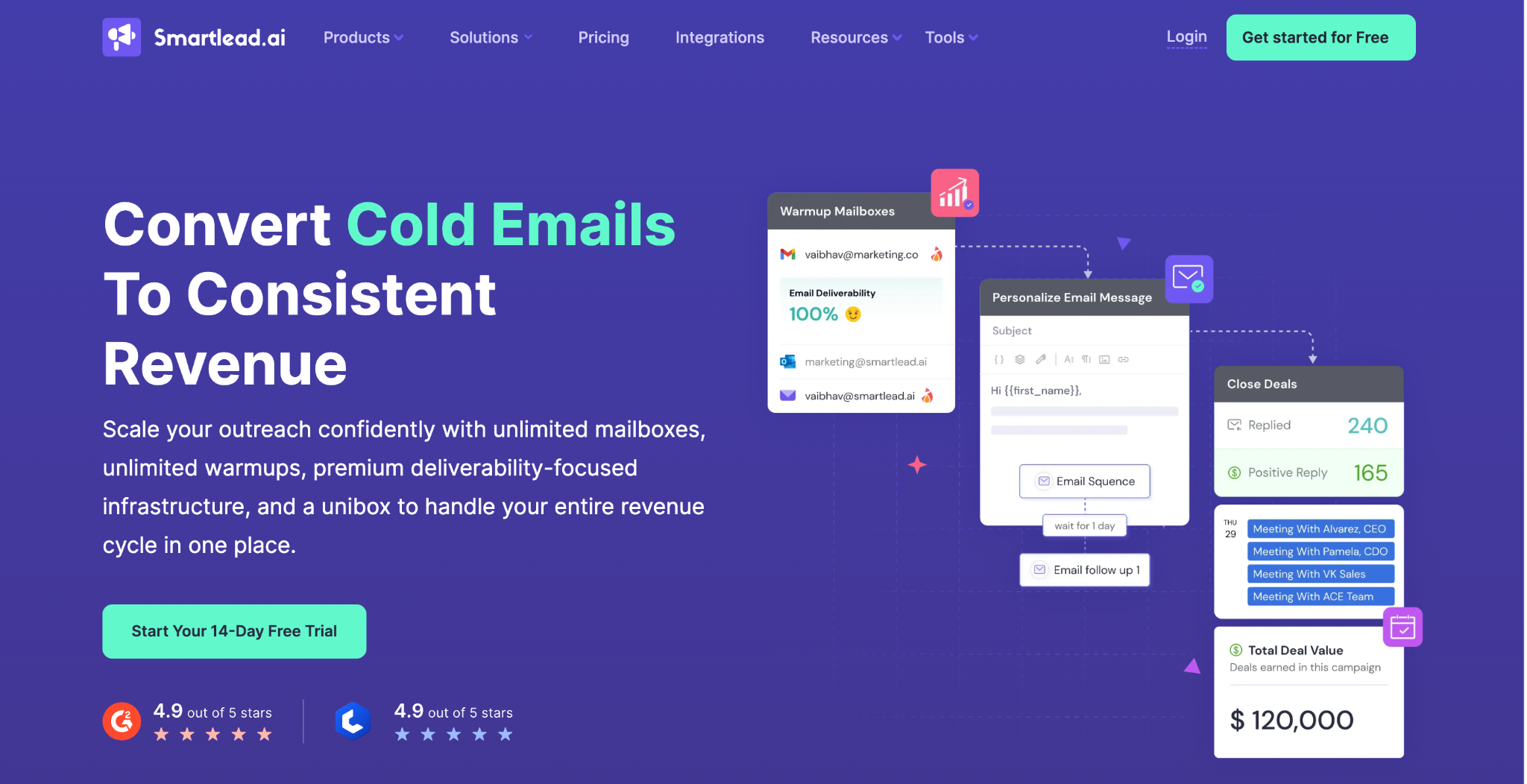
Smartlead.ai centralizes high‑volume outbound campaigns with advanced analytics and inbox management. It automates reply detection, handles lead routing, and scales personalized messages across multiple accounts simultaneously. All deliverability and engagement data sync to connected CRMs, giving revenue teams a unified view of campaign health and overall sales performance.
- Pros: Scalable campaign management; comprehensive analytics; multi‑inbox control.
- Cons: Learning curve for setup; limited AI‑based personalization.
- Best Fit: Large sales ops teams and agencies sending high volumes of outreach.
- Pricing: $39–$79 per month.
AI BDR vs. AI Sales Agent
While both roles use artificial intelligence to automate aspects of business development, their focus and level of autonomy differ significantly.
An AI BDR concentrates on the top of the funnel. It manages prospecting, lead generation, and initial qualification, essentially the repetitive tasks that front‑line business development representatives handle manually. AI BDRs send personalized emails, run multi‑channel outreach on social platforms like LinkedIn, and log follow‑up activity into CRMs. They excel at keeping pipeline volume high and response rates steady through automated engagement.
An AI Sales Agent, by contrast, operates deeper in the sales process. It can conduct autonomous conversations, handle calls, qualify buyer intent in real time, and book meetings or close transactions without human intervention. Where an AI BDR enhances prospecting efficiency, an AI Sales Agent extends automation across the entire cycle, from discovery to decision.
The distinction lies in scope and intelligence: BDRs are task automation specialists; Sales Agents are decision automation systems. For example, 11x’s Julian acts as an AI phone agent who qualifies inbound leads, revives aging contacts, and books meetings on your calendar autonomously, bridging the gap between traditional AI BDR functions and fully independent sales execution.
Example: 11x’s Julian acts as an AI dialer that qualifies inbound and revives leads instantly, bridging automation and real conversation.
How 11x Unifies the Sales Stack
Most AI BDR tools end at task automation. 11x connects every component of the sales workflow into one self‑learning loop:
- Aggregates CRM and intent data to identify qualified prospects.
- Uses AI agents to score and prioritize contacts in real time.
- Executes personalized email sequences and social outreach.
- Activates Julian’s AI dialer for calls and meeting booking.
- Syncs all results back to CRM systems like Salesforce and HubSpot.
The result is a streamlined sales process that runs autonomously, converting data into a pipeline without manual touch or multiple sales tools.
Use Cases and ROI for AI BDRs
AI BDRs create value across the entire sales funnel by connecting data, intent, and execution in real time. Each use case demonstrates how automation translates directly into revenue and efficiency gains for sales teams.
Lead Generation
AI BDRs continuously enrich contact records and qualify new prospects based on fit and intent signals. By analyzing behavior from LinkedIn, email responses, and website activity, they prioritize the most promising leads so teams can act immediately. With 11x, this process runs fully autonomously, Alice scores potential leads in real time and initiates personalized outreach the moment interest appears.
Nurture and Re‑Engagement
Beyond initial outreach, AI BDRs reactivate stale or inactive CRM records. Automated follow‑up sequences keep conversations alive without manual scheduling, drastically reducing lost pipeline. 11x’s adaptive messaging loops revive old opportunities and turn previous “no response” contacts into qualified calls.
Personalization at Scale
Traditional campaigns struggle to balance scale and relevance. AI systems solve that by generating personalized emails and multi‑channel touches that mirror real human communication. 11x’s Alice monitors engagement data and adjusts each interaction’s tone and timing for different ICP segments, creating a streamlined sales process that still feels customized.
CRM Optimization
AI integrations eliminate data entry and sync every activity across Salesforce, HubSpot, and Pipedrive. This keeps records accurate and prevents duplicate contacts or manual errors. For RevOps leaders, 11x provides a single source of truth for all sales engagement and ROI tracking.
Return on Investment
The payoff for implementing AI‑driven business development is both immediate and measurable. Teams using 11x report significant reductions in manual tasks and up to 500 thousand dollars in annual savings from automated pipeline creation alone. Beyond cost efficiency, AI improves conversion rates, boosts open and reply rates, and compresses sales cycles through real‑time engagement. These compounded gains make AI BDRs an essential driver of predictable revenue growth in modern sales teams.
Companies deploying 11x typically see shorter sales cycles, reduced manual activity costs (up to $500K annually), and faster pipeline velocity.
Future of AI BDRs
The next phase of sales automation relies on AI agents that research, message, and schedule without human input, collaborating across marketing and sales to accelerate revenue.
11x Alice and Julian learn from every interaction to continuously optimize your revenue engine, eliminating fragmented workflows and tool sprawl. Book a live demo to see how 11x’s AI agents can consistently drive net new pipeline for your sales team.
Frequently Asked Questions
High deliverability depends on consistent sending behavior, positive engagement rates, and active domain reputation management. AI tools track bounce rates and spam complaints to optimize campaigns automatically. In 11x, Alice manages domain warming, inbox rotation, and send‑limit optimization to protect reputation and maximize open rates through AI‑driven monitoring.
AI ranks prospects by fit and intent using real‑time data points like website visits, job changes, and email engagement. This allows sales teams to prioritize high‑quality leads and shorten response time. 11x automates the entire lead scoring process. Alice and Julian apply adaptive models that trigger follow‑ups or call workflows instantly when intent is detected.
CRM data decays quickly without constant maintenance. AI automatically fills, verifies, and updates contacts and firmographics from trusted sources, saving hours of manual research. Within 11x, digital workers sync real‑time firmographic and phone data across Salesforce and HubSpot, keeping records accurate and reps focused on outreach instead of data entry.
Modern AI sales tools sync through native connectors or open APIs to share activity data between platforms. Full integration means more accurate reporting and stable pipelines. 11x connects securely to Salesforce, HubSpot, and Pipedrive, logging each activity Alice and Julian perform so RevOps leaders see a single, unified pipeline view.
AI can outperform humans at scale and repetition, research, email send, and follow-up, but humans still excel at relationship building and strategic conversation. Many teams blend the two approaches. 11x enables that hybrid model by executing outreach autonomously while handing off high‑value leads to reps ready to close deals.



